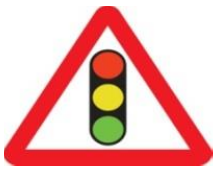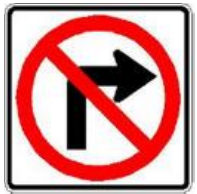9.
1 point
I often go……………..by myself after school.
A. cycle B. to cycle C. cycling D. to cycling
A
B
C
D
10.
1 point
Look! The fire engine_____ .
A. arrive B. arrives
C. is arriving D. are arriving
A
B
C
D
11.
1 point
Her brother is interested in swimming.
A. likes B. goes C. loves D. A & C
A
B
C
D
12.
1 point
He usually _________ two friends .
a. go with; b. goes with; c. go at; d. goes at
a
b
c
d
13.
1 point
He loves books very much. He…………….them every day.
A. is reading B. reading C. read D. reads
A
B
C
D
14.
1 point
I'm interested ______ photography.
a. in b. at c. on d. with
a
b
c
d
15.
1 point
Would you like to see a movie with me? - …………………………..
A. Yes. I would B. No. I wouldn’t C. Yes, I’d love to D. A & B
A
B
C
D
III. CAUTION SIGNS – WARNINGS:
16.
1 point

What does this sign mean ?
Stop
Danger
Traffic signal ahead
Parking
17.
1 point

What does the sign want us to do:
You can’t turn right
You can’t turn left
You can turn left
You can turn right
IV. CLOZE TEXTS: Choose the word (A, B, C or D) that best fits the blank space in the following passage
18.
6 points
Today is Sunday. Mai and her mother go to the (1) ___________. They want to buy some rice, meat and (2) __________ for dinner. They need a (3) ___________ of cooking oil.
Mai (4) ____________ some oranges and apples. They buy a kilo of oranges and two kilos of apples. They also want (5) ___________ rice and tea. They want ten kilos of rice and (6) _____________ packages of tea.
1. A. hotel B. house C. store D. post office
2. A. chairs B. desks C. beef D. books
3. A. box B. bar C. packet D. bottle
4. A. wants B. want C. to want D. is wanting
5. A. any B. some C. many D. a
6. A. a B. two C. second D. an
A B C D
1
A B C D
2
A B C D
3
A B C D
4
A B C D
5
A B C D
6
V. READING COMPREHENSION
Read the passage, then decide if the statements that follow it are TRUE or FALSE
19.
4 points
Nam has breakfast at 6:00. He has bread and eggs for his breakfast. Then he drinks some hot milk. It's his favorite drink. At 11:00 he has a big lunch with chicken, vegetables, soup and rice. He likes chicken very much. It's his favorite food. He has dinner at 6:00p.m. He doesn't like vegetables for dinner, so he has some fish, soup and rice. He drinks some orange juice for dinner.
1. Nam has breakfast at seven o'clock.
2. His favorite drink is hot milk.
3. He has chicken and fish for lunch.
4. Nam drinks orange juice for dinner.
Read the passage again then choose the best answer
5. The word “It” in bold:
A. milk B. drink C. chicken D. soup
6. The passage is about ________________
A. Nam’s routine B. Nam’s school
C. Nam’s favorite food D. Nam’s meals
True False A B C D
1
True False A B C D
2
True False A B C D
3
True False A B C D
4
True False A B C D
5
True False A B C D
6
VI. WORD FORMS:
20.
1 point
Tom is a good soccer………… (play)
21.
1 point
His father goes……….every morning (jog)
22.
1 point
Mary is ………… in listening to Pop music (interest)
23.
1 point
Hung and Tan are my best……………. (friendly)
VII. REARRANGEMENT: (sắp xếp câu)
24.
2 points
Phong /free time /listens to music /his /in/.
25.
2 points
you/ with/ go fishing/ do/ usually/ Who/?
26.
2 points
Peter/ in his room/ now/ his homework/ is doing/.
27.
2 points
goes shopping /her mother /always /with/ Mary/.
VIII. TRANSFORMATION (viết lại câu không đổi nghĩa)
28.
2 points
They travel to the beach two times a year.
--> They travel ________
29.
2 points
She usually walk to the park.
--> She usually _____________
30.
2 points
I love reading comic books in my free time.
--> I am ________
31.
2 points
What is the price of this phone?
How much ………………



1.C
2.C
3.A
4.B
5.B và C đều đúng
1. C
2. C
3. A
4. B
5. C
k mình nha